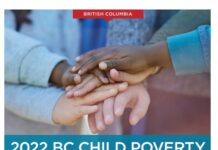FIRST Call Child and Youth Advocacy Society on Wednesday released the 25th annual BC Child Poverty Report Card finding that not much has changed for poor children and their families.
In 2019, the year this report covers, there were 156,560 (18%) children and youth living in poor households with many living in deep poverty. At 18%, BC had a slightly higher child poverty rate than Canada at 17.7%.
“We are encouraged to see the rate was down slightly from 2018 at 18.5% following the trend of gradual improvement since 2010 but progress is not fast enough for children whose health and development are at risk because they are poor,” the society said.
“Once again, our report finds one in five children in BC were living in poverty in 2019,” noted Adrienne Montani, First Call’s Executive Director. “A big surprise this year was the disparity between the average total incomes of the richest and poorest 10% of BC families with children – the difference was dramatic.”
Families in the highest income decile collected 24 times more than families in the lowest income decile. This was a larger disparity than the Canadian average ratio of 20.
The disparity for lone-parent families in BC was worse with the average income for the top 10% of lone-parent families at 54 times the average income for lone-parent families in the lowest decile. This was the highest income inequality ratio for lone-parent families of all provinces and territories.
Some of the 2019 findings include:
* The poverty rate for BC children in lone-parent families overall was 49%.
* BC’s early years (0-5 years old) child poverty rate, at 17.5% in 2019, was slightly lower than Canada’s early years child poverty rate at 18.5%.
* For only the second time in the past 20 years, in 2019, the child poverty rate in BC at 18% was similar to the-all ages poverty rate at 17.9%.
* The average child poverty rate on 64 BC First Nations reserves in 2019 was 40.9% with a higher rate on rural reserves (47.3%) than on urban reserves (35.4%).
Many of the regional districts with the highest child poverty rates were located in coastal areas, particularly along the north and central coastal areas.
The report contains 22 child poverty reduction recommendations for the provincial government including indexing the BC Child Opportunity Benefit to inflation to ensure the value of the benefit does not erode over time, ensuring their direct and contract employees are paid a living wage and continue to prioritize new child care investments.
2019 BC Child Poverty Report Card











